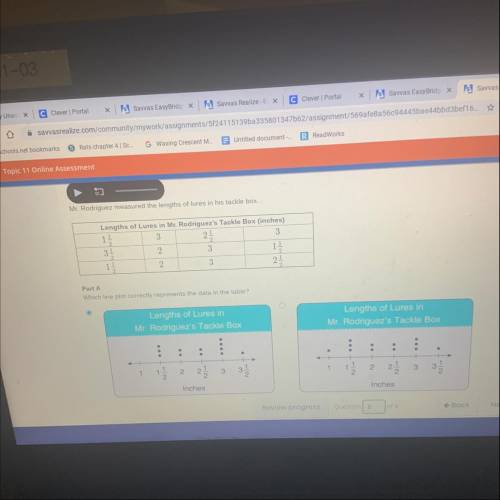
Mathematics, 23.04.2021 21:00 hgfgu1015
PLEASE HELP AND NO LINKS OR YOU WILL BE REPORTED
I need help with part B, I’m afraid I got this answer wrong because you are supposed choose the statements that are true and I’m afraid they are wrong, I chose the statements option 2, 3 and 5. The line plot in part A is correct so that can help you solve this as well but anyway the options are
The first is “The greatest length is 2 inches more than the least length.”
The second is “Less than half the lures are at least 3 inches long.”
The third is “The number of lures are greater than 2 1/2 inches long is less than the number of lures less than 2 1/2 inches
The fourth is “The greatest length is 2 inches.”
The fifth is “The number of lures is greater than 2 1/2 inches long is equal to the number of lures less than 2 1/2 inches.”


Answers: 2
Another question on Mathematics

Mathematics, 21.06.2019 17:30
Which of the following is true for the relation f(x)=2x^2+1
Answers: 1

Mathematics, 21.06.2019 18:00
Jack has a piece of red ribbon that is two times as long as his piece of blue ribbon. he says that he can use two different equation to find out how long his piece of red ribbon is compared to his piece of blue ribbon is. is he correct? explain his reasoning
Answers: 1

Mathematics, 21.06.2019 20:00
Find the value of x. round the length to the nearest tenth
Answers: 1

Mathematics, 21.06.2019 22:30
Amachine that produces a special type of transistor (a component of computers) has a 2% defective rate. the production is considered a random process where each transistor is independent of the others. (a) what is the probability that the 10th transistor produced is the first with a defect? (b) what is the probability that the machine produces no defective transistors in a batch of 100? (c) on average, how many transistors would you expect to be produced before the first with a defect? what is the standard deviation? (d) another machine that also produces transistors has a 5% defective rate where each transistor is produced independent of the others. on average how many transistors would you expect to be produced with this machine before the first with a defect? what is the standard deviation? (e) based on your answers to parts (c) and (d), how does increasing the probability of an event a↵ect the mean and standard deviation of the wait time until success?
Answers: 3
You know the right answer?
PLEASE HELP AND NO LINKS OR YOU WILL BE REPORTED
I need help with part B, I’m afraid I got this an...
Questions

Mathematics, 10.03.2020 23:09






Medicine, 10.03.2020 23:11

Mathematics, 10.03.2020 23:11


Chemistry, 10.03.2020 23:11



Mathematics, 10.03.2020 23:11



Mathematics, 10.03.2020 23:12

History, 10.03.2020 23:12



Mathematics, 10.03.2020 23:12



